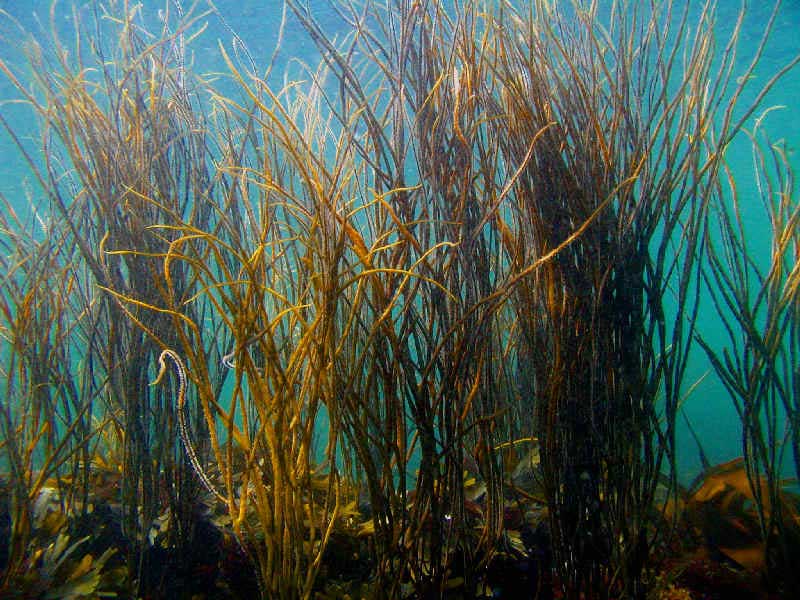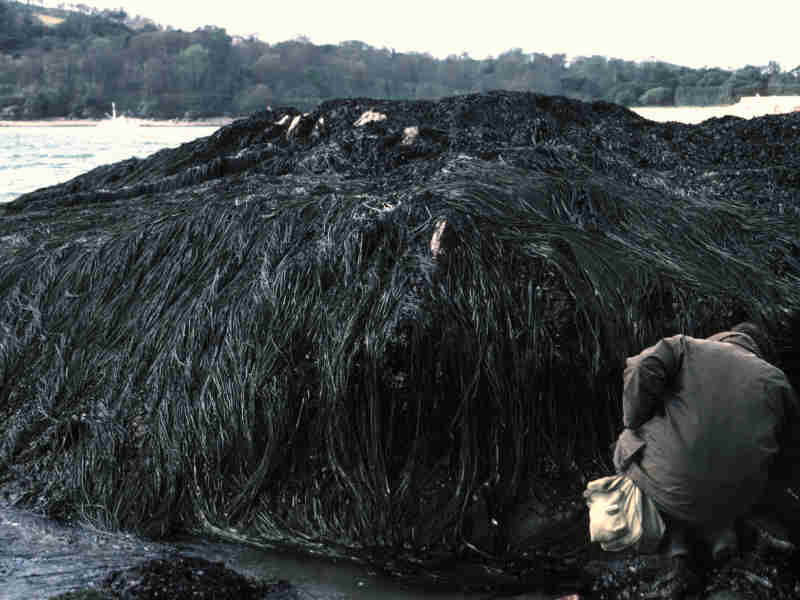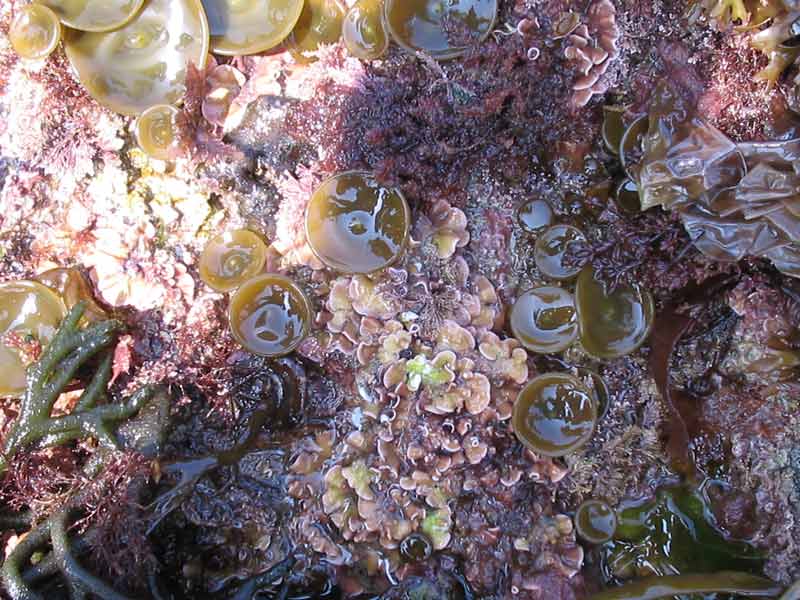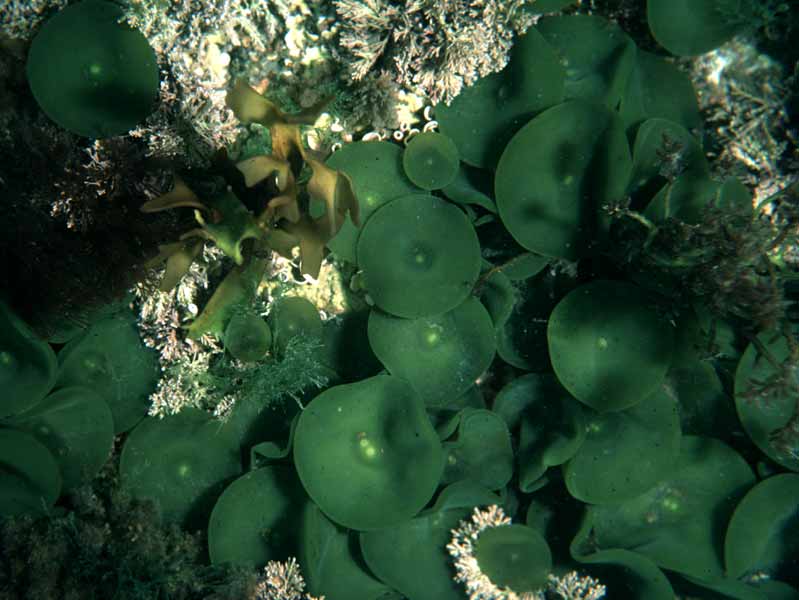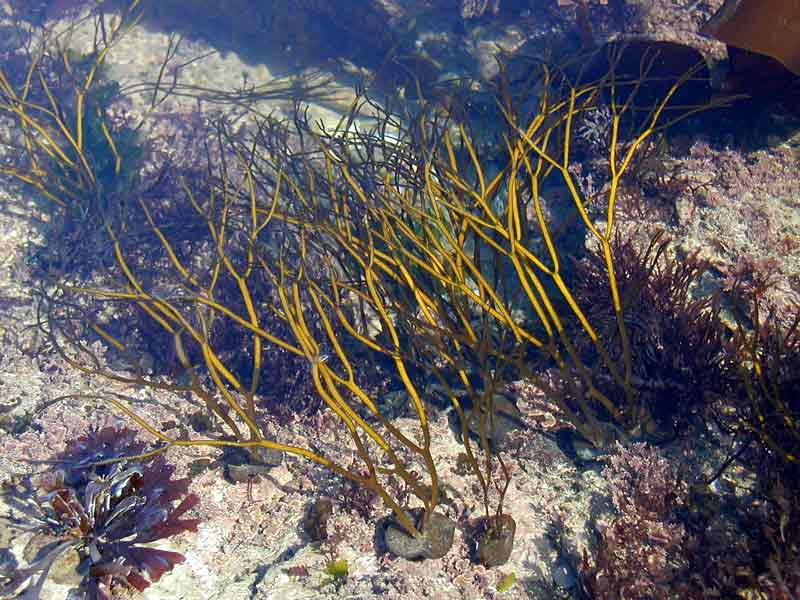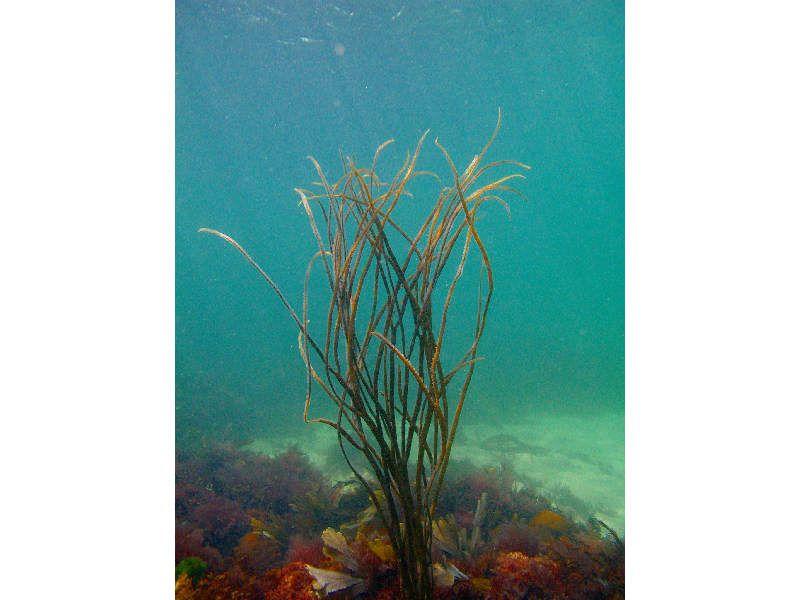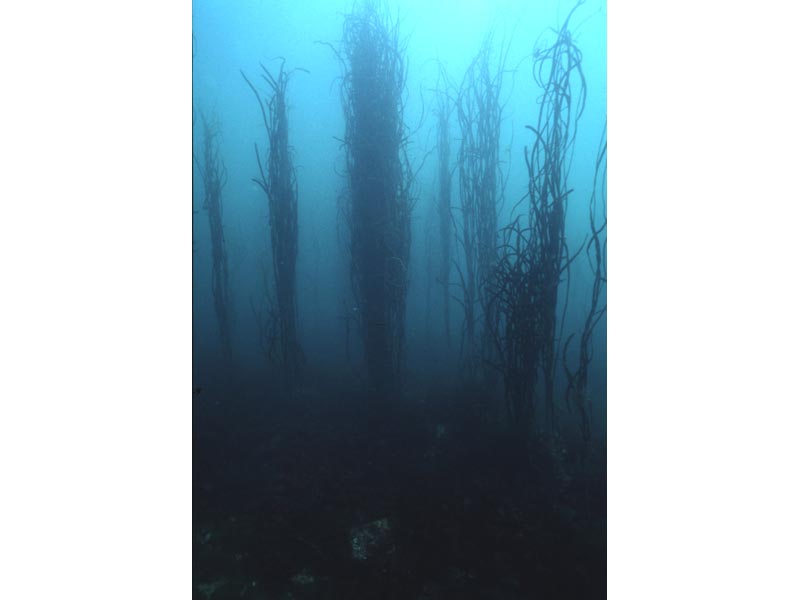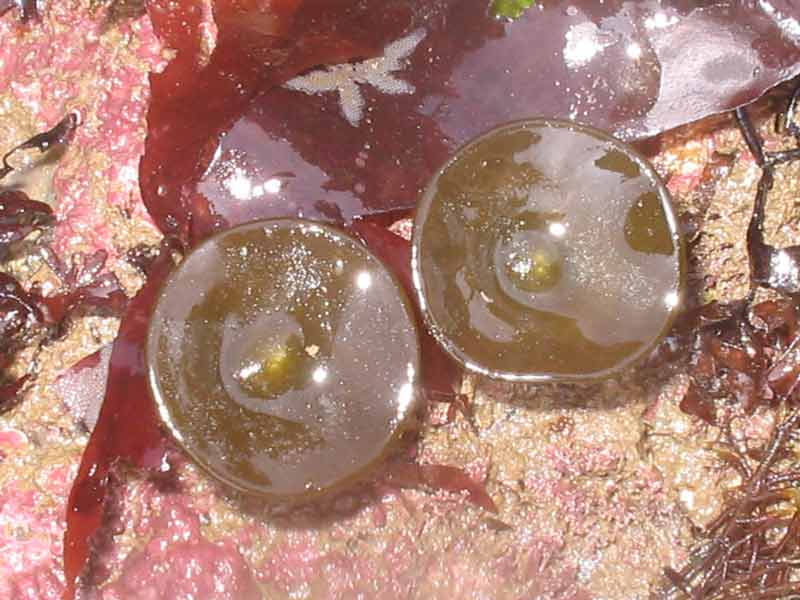Thongweed (Himanthalia elongata)
Distribution data supplied by the Ocean Biodiversity Information System (OBIS). To interrogate UK data visit the NBN Atlas.Map Help
| Researched by | Nicola White | Refereed by | Dr Dagmar Stengel |
| Authority | (Linnaeus) S.F.Gray, 1821 | ||
| Other common names | - | Synonyms | - |
Summary
Description
A common brown seaweed, which has a two stage morphology. Small button-like thalli are first produced, from which long strap-like reproductive fronds (receptacles) are formed in autumn. The strap-like reproductive fronds grow quickly between February and May, reaching a length of up to 2 m. The plant releases gametes from June until the winter when it starts to decay. Plants commonly live for 2-3 years and reproduce once before dying.
Recorded distribution in Britain and Ireland
All coasts of Britain and Ireland, except south east England.Global distribution
Norway, Britain, Ireland, north west coast of France, northern Spain and Portugal.Habitat
Himanthalia elongata is found attached to hard substrata on moderately exposed shores. It is found at the bottom of the shore, where it forms a band below Fucus serratus and above laminarians.Depth range
Not relevantIdentifying features
- Thallus is button-like with a short stipe and is up to 3 cm in diameter.
- Strap-like reproductive bodies are produced from the centre of the button, which are dichotomously branched.
- Up to 2 meters in length.
Additional information
Also commonly known as sea thong.
Listed by
- none -
Biology review
Taxonomy
| Level | Scientific name | Common name |
|---|---|---|
| Phylum | Ochrophyta | Brown and yellow-green seaweeds |
| Class | Phaeophyceae | |
| Order | Fucales | |
| Family | Himanthaliaceae | |
| Genus | Himanthalia | |
| Authority | (Linnaeus) S.F.Gray, 1821 | |
| Recent Synonyms | ||
Biology
| Parameter | Data | ||
|---|---|---|---|
| Typical abundance | Moderate density | ||
| Male size range | Up to 2 m | ||
| Male size at maturity | 15 mm | ||
| Female size range | 15 mm | ||
| Female size at maturity | |||
| Growth form | Capitate / Clubbed | ||
| Growth rate | max. 16mm/day | ||
| Body flexibility | |||
| Mobility | Sessile, permanent attachment | ||
| Characteristic feeding method | Autotroph | ||
| Diet/food source | |||
| Typically feeds on | Not relevant | ||
| Sociability | Solitary | ||
| Environmental position | Epifloral | ||
| Dependency | Independent. | ||
| Supports | None | ||
| Is the species harmful? | No | ||
Biology information
- Himanthalia elongata has a two stage morphology. A small button-like frond is first produced, from which large strap-like reproductive fronds are formed. The button stage is clubbed shaped at first and then develops into a button shape 2-3 cm in diameter, which is connected to the substrate by a holdfast and short stipe. Each button typically produces 2 strap-like reproductive fronds in autumn, although plants have been observed with 1 to 4 straps.
- "Growth rate" refers to growth of reproductive straps at 10-12 degrees C, which is the optimum growing temperature in spring.
- "Size at maturity" refers to the minimum diameter of the button, which is required for it to produce receptacles.
Habitat preferences
| Parameter | Data |
|---|---|
| Physiographic preferences | Open coast, Strait or Sound, Sea loch or Sea lough, Ria or Voe |
| Biological zone preferences | Lower eulittoral, Sublittoral fringe |
| Substratum / habitat preferences | Bedrock, Large to very large boulders |
| Tidal strength preferences | Moderately strong 1 to 3 knots (0.5-1.5 m/sec.), Strong 3 to 6 knots (1.5-3 m/sec.), Weak < 1 knot (<0.5 m/sec.) |
| Wave exposure preferences | Moderately exposed, Sheltered |
| Salinity preferences | Full (30-40 psu) |
| Depth range | Not relevant |
| Other preferences | No text entered |
| Migration Pattern | Non-migratory or resident |
Habitat Information
- The distribution of Himanthalia elongata appears to be controlled by the degree of wave exposure, presence of tidal currents and the availability of suitable substrata. The species grows best in areas with strong tidal currents and is most commonly found on semi-exposed shores where, it can be locally abundant. It is rarely found in exposed shores and occasionally forms dense stands on sheltered shores.
- The degree of exposure to waves is also important in determining the persistence of adult plants on the shore. On exposed sites, adult plants may only be present until October, whereas on sheltered sites, plants may be present until February.
- Zygotes of this species are intolerant of lowered salinity and silt, restricting the species' distribution. Himanthalia elongata is typically found in the lower eulittoral and sometimes extends into the shallow sublittoral. The species can tolerate the physical conditions found further up the shore, but it is prevented from growing there by grazing pressure.
- Plants from exposed sites tend to be shorter and have fewer, narrower receptacles. Plants grow well in the presence of a red algal turf, which offers protection to young vegetative stages from wave action.
Life history
Adult characteristics
| Parameter | Data |
|---|---|
| Reproductive type | Gonochoristic (dioecious) |
| Reproductive frequency | Semelparous or monotely |
| Fecundity (number of eggs) | No information |
| Generation time | 2-5 years |
| Age at maturity | 2 year |
| Season | June - December |
| Life span | 2-5 years |
Larval characteristics
| Parameter | Data |
|---|---|
| Larval/propagule type | - |
| Larval/juvenile development | Not relevant |
| Duration of larval stage | No information |
| Larval dispersal potential | No information |
| Larval settlement period | Insufficient information |
Life history information
- Himanthalia elongata has a life history and growth pattern unique among the Fucales. The species invests 98 percent of the total biomass in reproductive rather than vegetative tissue. It is usually has a biennial lifecycle, reproducing once and then dying.
- The reproductive bodies or receptacles take the form of long straps, which sprout from the centre of the button. When the plants are fertile the straps become mottled with brown spots, each spot with a pale centre marking the opening to the conceptacle.
- Gametes are released from June until winter. Usually germlings become visible on the shore in early March and form buttons with an average size of 10-25 mm by August. Those buttons which grow to 15 mm by November produce receptacles that autumn. The receptacles grow little in length during autumn and winter but increase rapidly between February and May. From June onwards, adult plants release gametes on a low tide by liberating them into mucus, which dribbles onto the substratum below. The time of reproduction is strongly site dependent, probably due to water temperature.
- Zygotes of the species are very large in comparison to most seaweeds. They are spherical, heavy and measure 0.2mm across so that they rapidly settle to the substratum. After fertilisation there is a long period of 5-7 days before attaching rhizoids develop. During this period the zygote is anchored to the substratum using the fertilization membrane, which is expanded into a wide brim. Zygotes are incapable of growing on silt, but germlings are tolerant of temporary cover by drifting sand.
- Gamete dispersal is thought to be limited so recruitment from external populations is probably low. Early germling growth is probably strongly influenced by the presence of adults, as reproductive thalli provide protection from desiccation and high irradiances, although shading could limit growth rate of germlings (Stengel, pers. comm.).
Sensitivity review
The MarLIN sensitivity assessment approach used below has been superseded by the MarESA (Marine Evidence-based Sensitivity Assessment) approach (see menu). The MarLIN approach was used for assessments from 1999-2010. The MarESA approach reflects the recent conservation imperatives and terminology and is used for sensitivity assessments from 2014 onwards.
Physical pressures
Use / to open/close text displayed
| Intolerance | Recoverability | Sensitivity | Evidence / Confidence | |
Substratum loss [Show more]Substratum lossBenchmark. All of the substratum occupied by the species or biotope under consideration is removed. A single event is assumed for sensitivity assessment. Once the activity or event has stopped (or between regular events) suitable substratum remains or is deposited. Species or community recovery assumes that the substratum within the habitat preferences of the original species or community is present. Further details EvidenceHimanthalia elongata is permanently attached to the substratum, so it would be removed upon substratum loss. The species recruited to concrete blocks placed in the intertidal zone (within an existent population of Himanthalia elongata) at an average level of 45 buttons per block (968 sq. cm in area) in March of the first year, dropping to only 4 or 5 buttons per block by early summer, but rising to 1500 buttons per block by March of the second year (Stengel et al., 1999). However, the zygotes are relatively large, heavy and settle out rapidly (Moss et al. 1973) and probably have limited dispersal capability. Subsequent survival of early germlings is dependant on the presence of adult thalli or other foliose algae providing protection from desiccation, wave action and high irradiances, although shading probably limits growth rates of the germlings (Stengel et al., 1999; Stengel pers. comm.). Dispersal of gametes is probably very limited (Stengel pers. comm.). Although the above suggests that recovery may take 1-2 years in the vicinity of populations of this species (depending on the time of year); recovery by recruitment from other populations may take longer. Therefore, recovery is reported as high; populations may take up to 5 years to re-establish. | High | High | Moderate | Moderate |
Smothering [Show more]SmotheringBenchmark. All of the population of a species or an area of a biotope is smothered by sediment to a depth of 5 cm above the substratum for one month. Impermeable materials, such as concrete, oil, or tar, are likely to have a greater effect. Further details. EvidenceSmothering would cover and probably kill the button-like vegetative bodies of Himanthalia elongata. The species recruited to concrete blocks placed in the intertidal zone (within an existent population of Himanthalia elongata) at an average level of 45 buttons per block (968 sq. cm in area) in March of the first year, dropping to only 4 or 5 buttons per block by early summer, but rising to 1500 buttons per block by March of the second year (Stengel et al., 1999). However, the zygotes are relatively large, heavy and settle out rapidly (Moss et al. 1973) and probably have limited dispersal capability. Subsequent survival of early germlings is dependant on the presence of adult thalli or other foliose algae providing protection from desiccation, wave action and high irradiances, although shading probably limits growth rates of the germlings (Stengel et al., 1999; Stengel pers. comm.). Dispersal of gametes is probably very limited (Stengel pers. comm.). Although the above suggests that recovery may take 1-2 years in the vicinity of populations of this species (depending on the time of year); recovery by recruitment from other populations may take longer. Therefore, recovery is reported as high; populations may take up to 5 years to re-establish. | High | High | Moderate | Low |
Increase in suspended sediment [Show more]Increase in suspended sedimentBenchmark. An arbitrary short-term, acute change in background suspended sediment concentration e.g., a change of 100 mg/l for one month. The resultant light attenuation effects are addressed under turbidity, and the effects of rapid settling out of suspended sediment are addressed under smothering. Further details EvidenceSilt may settle out on the fronds of Himanthalia elongata, reducing light available for photosynthesis and lowering growth rates. Young stages of the species are very intolerant of siltation (Moss et al., 1973) so the impact of the factor would depend on the time of year when it happened. If siltation occurred from June to December, when gametes are released, the population would be highly intolerant because zygotes cannot grow on silt (Moss et al., 1973). The species recruited to concrete blocks placed in the intertidal zone (within an existent population of Himanthalia elongata) at an average level of 45 buttons per block (968 sq. cm in area) in March of the first year, dropping to only 4 or 5 buttons per block by early summer, but rising to 1500 buttons per block by March of the second year (Stengel et al., 1999). However, the zygotes are relatively large, heavy and settle out rapidly (Moss et al. 1973) and probably have limited dispersal capability. Subsequent survival of early germlings is dependant on the presence of adult thalli or other foliose algae providing protection from desiccation, wave action and high irradiances, although shading probably limits growth rates of the germlings (Stengel et al., 1999; Stengel pers. comm.). Dispersal of gametes is probably very limited (Stengel pers. comm.). Although the above suggests that recovery may take 1-2 years in the vicinity of populations of this species (depending on the time of year); recovery by recruitment from other populations may take longer. Therefore, recovery is reported as high; populations may take up to 5 years to re-establish. | High | High | Moderate | Moderate |
Decrease in suspended sediment [Show more]Decrease in suspended sedimentBenchmark. An arbitrary short-term, acute change in background suspended sediment concentration e.g., a change of 100 mg/l for one month. The resultant light attenuation effects are addressed under turbidity, and the effects of rapid settling out of suspended sediment are addressed under smothering. Further details Evidence | No information | |||
Desiccation [Show more]Desiccation
EvidenceHimanthalia elongata can tolerate some increase in desiccation because the upper limit of the algae is controlled by biological interactions rather than physiological tolerance. After the Torrey Canyon oil spill, which killed limpets, Himanthalia elongata extended temporarily 2m vertically up the shore (Southward & Southward, 1978). The species also suffered no damage during the unusually hot summer of 1983 (Hawkins & Hartnoll, 1985), when it suffered increased desiccation. However, vegetative and reproductive plants died during hot weather during spring tides in Co. Clare (Stengel, pers. comm.). Therefore intolerance to desiccation is reported as high. The species recruited to concrete blocks placed in the intertidal zone (within an existent population of Himanthalia elongata) at an average level of 45 buttons per block (968 sq. cm in area) in March of the first year, dropping to only 4 or 5 buttons per block by early summer, but rising to 1500 buttons per block by March of the second year (Stengel et al., 1999). However, the zygotes are relatively large, heavy and settle out rapidly (Moss et al. 1973) and probably have limited dispersal capability. Subsequent survival of early germlings is dependant on the presence of adult thalli or other foliose algae providing protection from desiccation, wave action and high irradiances, although shading probably limits growth rates of the germlings (Stengel et al., 1999; Stengel pers. comm.). Dispersal of gametes is probably very limited (Stengel pers. comm.). Although the above suggests that recovery may take 1-2 years in the vicinity of populations of this species (depending on the time of year); recovery by recruitment from other populations may take longer. Therefore, recovery is reported as high; populations may take up to 5 years to re-establish. | High | High | Moderate | Moderate |
Increase in emergence regime [Show more]Increase in emergence regimeBenchmark. A one hour change in the time covered or not covered by the sea for a period of one year. Further details EvidenceHimanthalia elongata may physiologically tolerate an increase in the period of emergence because it has been found to grow 2m vertically further up the shore in the absence of limpets (Southward & Southward, 1978). However, an increase in the period of emergence would probably result in a depression of the species upper limit on the shore. A reduction in the period of emersion would conversely allow the upper limit of the species to extend further up the shore. The species recruited to concrete blocks placed in the intertidal zone (within an existent population of Himanthalia elongata) at an average level of 45 buttons per block (968 sq. cm in area) in March of the first year, dropping to only 4 or 5 buttons per block by early summer, but rising to 1500 buttons per block by March of the second year (Stengel et al., 1999). However, the zygotes are relatively large, heavy and settle out rapidly (Moss et al. 1973) and probably have limited dispersal capability. Subsequent survival of early germlings is dependant on the presence of adult thalli or other foliose algae providing protection from desiccation, wave action and high irradiances, although shading probably limits growth rates of the germlings (Stengel et al., 1999; Stengel pers. comm.). Dispersal of gametes is probably very limited (Stengel pers. comm.). Although the above suggests that recovery may take 1-2 years in the vicinity of populations of this species (depending on the time of year); recovery by recruitment from other populations may take longer. Therefore, recovery is reported as high; populations may take up to 5 years to re-establish. | Intermediate | High | Low | Moderate |
Decrease in emergence regime [Show more]Decrease in emergence regimeBenchmark. A one hour change in the time covered or not covered by the sea for a period of one year. Further details Evidence | No information | |||
Increase in water flow rate [Show more]Increase in water flow rateA change of two categories in water flow rate (view glossary) for 1 year, for example, from moderately strong (1-3 knots) to very weak (negligible). Further details EvidenceHimanthalia elongata can tolerate fairly strong currents, as evidenced by its presence in tidal rapids in Lough Ine, Ireland. An increase in tidal strength may lead to plants being torn off the substratum resulting in poor settlement of germlings. Alternatively the substratum with plants attached may be mobilised. The species recruited to concrete blocks placed in the intertidal zone (within an existent population of Himanthalia elongata) at an average level of 45 buttons per block (968 sq. cm in area) in March of the first year, dropping to only 4 or 5 buttons per block by early summer, but rising to 1500 buttons per block by March of the second year (Stengel et al., 1999). However, the zygotes are relatively large, heavy and settle out rapidly (Moss et al. 1973) and probably have limited dispersal capability. Subsequent survival of early germlings is dependant on the presence of adult thalli or other foliose algae providing protection from desiccation, wave action and high irradiances, although shading probably limits growth rates of the germlings (Stengel et al., 1999; Stengel pers. comm.). Dispersal of gametes is probably very limited (Stengel pers. comm.). Although the above suggests that recovery may take 1-2 years in the vicinity of populations of this species (depending on the time of year); recovery by recruitment from other populations may take longer. Therefore, recovery is reported as high; populations may take up to 5 years to re-establish. | Intermediate | High | Low | Low |
Decrease in water flow rate [Show more]Decrease in water flow rateA change of two categories in water flow rate (view glossary) for 1 year, for example, from moderately strong (1-3 knots) to very weak (negligible). Further details Evidence | No information | |||
Increase in temperature [Show more]Increase in temperature
For intertidal species or communities, the range of temperatures includes the air temperature regime for that species or community. Further details EvidenceGermination and vegetative growth in Himanthalia elongata are highly intolerant of reductions in temperature and are limited at temperatures below 15 degrees C (Stengel, 2000 in prep.). This species is less intolerant of increases in temperature as plants survived the unusually hot summer of 1983 apart from a slight bleaching of buttons (Hawkins & Hartnoll, 1985). | Intermediate | High | Low | Low |
Decrease in temperature [Show more]Decrease in temperature
For intertidal species or communities, the range of temperatures includes the air temperature regime for that species or community. Further details Evidence | No information | |||
Increase in turbidity [Show more]Increase in turbidity
EvidenceAn increase in turbidity would reduce the light available for photosynthesis and therefore lower growth rates. A prolonged occurrence of increased turbidity will delay vegetative growth and may result in a failure to become fertile in autumn (Stengel, pers. comm.) On return to normal turbidity levels the growth rate would be quickly restored. | Low | Very high | Very Low | Moderate |
Decrease in turbidity [Show more]Decrease in turbidity
Evidence | No information | |||
Increase in wave exposure [Show more]Increase in wave exposureA change of two ranks on the wave exposure scale (view glossary) e.g., from Exposed to Extremely exposed for a period of one year. Further details EvidenceHimanthalia elongata is mostly found on moderately exposed shores. An increase in wave action would result in plants and germlings being torn off the substratum and cause a shift in the community to barnacles. A decrease in the level of wave action would result in the species being displaced by faster growing fucoids such as Fucus serratus. The species recruited to concrete blocks placed in the intertidal zone (within an existent population of Himanthalia elongata) at an average level of 45 buttons per block (968 sq. cm in area) in March of the first year, dropping to only 4 or 5 buttons per block by early summer, but rising to 1500 buttons per block by March of the second year (Stengel et al., 1999). However, the zygotes are relatively large, heavy and settle out rapidly (Moss et al. 1973) and probably have limited dispersal capability. Subsequent survival of early germlings is dependant on the presence of adult thalli or other foliose algae providing protection from desiccation, wave action and high irradiances, although shading probably limits growth rates of the germlings (Stengel et al., 1999; Stengel pers. comm.). Dispersal of gametes is probably very limited (Stengel pers. comm.). Although the above suggests that recovery may take 1-2 years in the vicinity of populations of this species (depending on the time of year); recovery by recruitment from other populations may take longer. Therefore, recovery is reported as high; populations may take up to 5 years to re-establish. | High | High | Moderate | Moderate |
Decrease in wave exposure [Show more]Decrease in wave exposureA change of two ranks on the wave exposure scale (view glossary) e.g., from Exposed to Extremely exposed for a period of one year. Further details Evidence | No information | |||
Noise [Show more]Noise
EvidenceSeaweeds have no known mechanism for the perception of noise. | Tolerant | Not relevant | Not sensitive | Moderate |
Visual presence [Show more]Visual presenceBenchmark. The continuous presence for one month of moving objects not naturally found in the marine environment (e.g., boats, machinery, and humans) within the visual envelope of the species or community under consideration. Further details EvidenceSeaweeds have no known mechanism for visual perception. | Tolerant | Not relevant | Not sensitive | Moderate |
Abrasion & physical disturbance [Show more]Abrasion & physical disturbanceBenchmark. Force equivalent to a standard scallop dredge landing on or being dragged across the organism. A single event is assumed for assessment. This factor includes mechanical interference, crushing, physical blows against, or rubbing and erosion of the organism or habitat of interest. Where trampling is relevant, the evidence and trampling intensity will be reported in the rationale. Further details. EvidencePhysical disturbance by anchors or a passing scallop dredge may damage fronds of established seaweeds and kill germlings. Abrasion may be caused by human trampling, which has been shown to reduce algal cover on shores (Holt et al., 1997). However, Himanthalia elongata is unlikely to be subject to heavy trampling because it only occurs near the low water springs mark. Therefore, intolerance has been assessed as intermediate.The species recruited to concrete blocks placed in the intertidal zone (within an existent population of Himanthalia elongata) at an average level of 45 buttons per block (968 sq. cm in area) in March of the first year, dropping to only 4 or 5 buttons per block by early summer, but rising to 1500 buttons per block by March of the second year (Stengel et al., 1999). However, the zygotes are relatively large, heavy and settle out rapidly (Moss et al. 1973) and probably have limited dispersal capability. Subsequent survival of early germlings is dependant on the presence of adult thalli or other foliose algae providing protection from desiccation, wave action and high irradiances, although shading probably limits growth rates of the germlings (Stengel et al., 1999; Stengel pers. comm.). Dispersal of gametes is probably very limited (Stengel pers comm.). Although the above suggests that recovery may take 1-2 years in the vicinity of populations of this species (depending on the time of year); recovery by recruitment from other populations may take longer. Therefore, recovery is reported as high; populations may take up to 5 years to re-establish. | Intermediate | High | Low | Low |
Displacement [Show more]DisplacementBenchmark. Removal of the organism from the substratum and displacement from its original position onto a suitable substratum. A single event is assumed for assessment. Further details EvidenceHimanthalia elongata is permanently attached to the substratum and once removed it cannot survive. The species recruited to concrete blocks placed in the intertidal zone (within an existent population of Himanthalia elongata) at an average level of 45 buttons per block (968 sq. cm in area) in March of the first year, dropping to only 4 or 5 buttons per block by early summer, but rising to 1500 buttons per block by March of the second year (Stengel et al., 1999). However, the zygotes are relatively large, heavy and settle out rapidly (Moss et al. 1973) and probably have limited dispersal capability. Subsequent survival of early germlings is dependant on the presence of adult thalli or other foliose algae providing protection from desiccation, wave action and high irradiances, although shading probably limits growth rates of the germlings (Stengel et al., 1999; Stengel pers. comm.). Dispersal of gametes is probably very limited (Stengel pers. comm.). Although the above suggests that recovery may take 1-2 years in the vicinity of populations of this species (depending on the time of year); recovery by recruitment from other populations may take longer. Therefore, recovery is reported as high; populations may take up to 5 years to re-establish. | High | High | Moderate | Moderate |
Chemical pressures
Use [show more] / [show less] to open/close text displayed
| Intolerance | Recoverability | Sensitivity | Evidence / Confidence | |
Synthetic compound contamination [Show more]Synthetic compound contaminationSensitivity is assessed against the available evidence for the effects of contaminants on the species (or closely related species at low confidence) or community of interest. For example:
The evidence used is stated in the rationale. Where the assessment can be based on a known activity then this is stated. The tolerance to contaminants of species of interest will be included in the rationale when available; together with relevant supporting material. Further details. EvidenceHimanthalia elongata was not affected by dispersants used after the 'Torrey Canyon' oil spill. Indeed the species increased its vertical range as a result of the loss of grazing gastropods (Southward & Southward, 1978). | Low | High | Low | Low |
Heavy metal contamination [Show more]Heavy metal contaminationEvidenceInsufficientinformation | No information | Not relevant | No information | Not relevant |
Hydrocarbon contamination [Show more]Hydrocarbon contaminationEvidenceHimanthalia elongata survived the 'Torrey Canyon' oil spill and indeed extended 2 m vertically up the shore, due to the absence of grazers (Southward & Southward, 1978). The species lives in the lower eulittoral and sublittoral fringe, which means that oil will rapidly be washed off the fronds. It also usually occurs in areas with strong currents, so oil would be dispersed more quickly. Therefore, it is predicted that oil does not have a substantial impact on the species. | Intermediate | High | Low | Low |
Radionuclide contamination [Show more]Radionuclide contaminationEvidenceInsufficientinformation | No information | Not relevant | No information | Not relevant |
Changes in nutrient levels [Show more]Changes in nutrient levelsEvidenceNutrients are required for algal growth. A small increase in nutrient levels may enhance growth rates but large increases have a detrimental effect by leading to overgrowth of brown seaweeds by green algae (Fletcher, 1996). Decreases in nutrient levels may slow down algal growth. The species recruited to concrete blocks placed in the intertidal zone (within an existent population of Himanthalia elongata) at an average level of 45 buttons per block (968 sq. cm in area) in March of the first year, dropping to only 4 or 5 buttons per block by early summer, but rising to 1500 buttons per block by March of the second year (Stengel et al., 1999). However, the zygotes are relatively large, heavy and settle out rapidly (Moss et al. 1973) and probably have limited dispersal capability. Subsequent survival of early germlings is dependant on the presence of adult thalli or other foliose algae providing protection from desiccation, wave action and high irradiances, although shading probably limits growth rates of the germlings (Stengel et al., 1999; Stengel pers. comm.). Dispersal of gametes is probably very limited (Stengel pers. comm.). Although the above suggests that recovery may take 1-2 years in the vicinity of populations of this species (depending on the time of year); recovery by recruitment from other populations may take longer. Therefore, recovery is reported as high; populations may take up to 5 years to re-establish. | Intermediate | High | Low | Low |
Increase in salinity [Show more]Increase in salinity
EvidenceHimanthalia elongata is intolerant of salinity because reduced salinity has an adverse effect on zygote development. When salinity is below 21 psu few eggs survive (Moss et al., 1973). The species recruited to concrete blocks placed in the intertidal zone (within an existent population of Himanthalia elongata) at an average level of 45 buttons per block (968 sq. cm in area) in March of the first year, dropping to only 4 or 5 buttons per block by early summer, but rising to 1500 buttons per block by March of the second year (Stengel et al., 1999). However, the zygotes are relatively large, heavy and settle out rapidly (Moss et al. 1973) and probably have limited dispersal capability. Subsequent survival of early germlings is dependant on the presence of adult thalli or other foliose algae providing protection from desiccation, wave action and high irradiances, although shading probably limits growth rates of the germlings (Stengel et al., 1999; Stengel pers. comm.). Dispersal of gametes is probably very limited (Stengel pers. comm.). Although the above suggests that recovery may take 1-2 years in the vicinity of populations of this species (depending on the time of year); recovery by recruitment from other populations may take longer. Therefore, recovery is reported as high; populations may take up to 5 years to re-establish. | High | High | Moderate | Moderate |
Decrease in salinity [Show more]Decrease in salinity
Evidence | No information | |||
Changes in oxygenation [Show more]Changes in oxygenationBenchmark. Exposure to a dissolved oxygen concentration of 2 mg/l for one week. Further details. EvidenceInsufficientinformation | No information | Not relevant | No information | Not relevant |
Biological pressures
Use [show more] / [show less] to open/close text displayed
| Intolerance | Recoverability | Sensitivity | Evidence / Confidence | |
Introduction of microbial pathogens/parasites [Show more]Introduction of microbial pathogens/parasitesBenchmark. Sensitivity can only be assessed relative to a known, named disease, likely to cause partial loss of a species population or community. Further details. EvidenceInsufficientinformation | No information | Not relevant | No information | Not relevant |
Introduction of non-native species [Show more]Introduction of non-native speciesSensitivity assessed against the likely effect of the introduction of alien or non-native species in Britain or Ireland. Further details. EvidenceInsufficientinformation | No information | Not relevant | No information | Not relevant |
Extraction of this species [Show more]Extraction of this speciesBenchmark. Extraction removes 50% of the species or community from the area under consideration. Sensitivity will be assessed as 'intermediate'. The habitat remains intact or recovers rapidly. Any effects of the extraction process on the habitat itself are addressed under other factors, e.g. displacement, abrasion and physical disturbance, and substratum loss. Further details. EvidenceHimanthalia elongata rapidly recruits to cleared areas of the shore (Stengel et al., 1999), so provided not too much of the shore is harvested the species would be able to recover relatively quickly. | Intermediate | High | Low | Low |
Extraction of other species [Show more]Extraction of other speciesBenchmark. A species that is a required host or prey for the species under consideration (and assuming that no alternative host exists) or a keystone species in a biotope is removed. Any effects of the extraction process on the habitat itself are addressed under other factors, e.g. displacement, abrasion and physical disturbance, and substratum loss. Further details. EvidenceExtraction of grazers from semi-exposed shores, such as limpets and littorinids, could cause the upper limit of Himanthalia elongata to extend up the shore. This species could also be affected by trampling from humans harvesting red algae in the vicinity. | Tolerant* | Not relevant | Not sensitive* | Low |
Additional information
Importance review
Policy/legislation
- no data -
Status
| National (GB) importance | - | Global red list (IUCN) category | - |
Non-native
| Parameter | Data |
|---|---|
| Native | - |
| Origin | - |
| Date Arrived | Not relevant |
Importance information
- Himanthalia elongata is eaten as a food in Ireland and France. It is sold dried and pickled or may be eaten fresh in a salad. The species is harvested commercially on the west coast of Ireland on a small scale (Stengel et al., 1999). Large quantities have also been harvested in Brittany for use in the cultivation of artichokes (Guiry & Blunden, 1991) and it is used in beauty products such as facial cleansers.
- The epifauna and epiflora of Himanthalia elongata was described by Kitching (1987). He recorded 105 species of flora and fauna on Himanthalia plants in Lough Hyne. The upper surface of the buttons are very resistant to colonization by epiphytes while the underside of the buttons are usually colonized by Bryozoa and spirorbid worms. The straps are frequently covered in a microforest of filamentous algae, such as Ectocarpus siliculosus, Ceramium pedicellatum and Ulva prolifera. Fauna such as the gastropods Rissoa pavida & juvenile Patella pellucida and amphipods, are often associated with the above filamentous epiphytes.
Bibliography
Fletcher, R.L., 1996. The occurrence of 'green tides' - a review. In Marine Benthic Vegetation. Recent changes and the Effects of Eutrophication (ed. W. Schramm & P.H. Nienhuis). Berlin Heidelberg: Springer-Verlag. [Ecological Studies, vol. 123].
Guiry, M.D. & Blunden, G., 1991. Seaweed Resources in Europe: Uses and Potential. Chicester: John Wiley & Sons.
Hardy, F.G. & Guiry, M.D., 2003. A check-list and atlas of the seaweeds of Britain and Ireland. London: British Phycological Society
Hawkins, S.J. & Hartnoll, R.G., 1985. Factors determining the upper limits of intertidal canopy-forming algae. Marine Ecology Progress Series, 20, 265-271.
Kitching, J.A., 1987. The fauna and flora associated with Himanthalia elongata (L) S. F. Gray in relation to water current and wave action in the Lough Hyne Marine Nature Reserve. Estuarine, Coastal and Shelf Science, 25, 663-676.
Moss, B., Mercer, S., & Sheader, A., 1973. Factors Affecting the Distribution of Himanthalia elongata (L.) S.F. Gray on the North-east Coast of England. Estuarine and Coastal Marine Science, 1, 233-243.
Southward, A.J. & Southward, E.C., 1978. Recolonisation of rocky shores in Cornwall after use of toxic dispersants to clean up the Torrey Canyon spill. Journal of the Fisheries Research Board of Canada, 35, 682-706.
Stengel, D.B., Wilkes, R.J. & Guiry, M.D., 1999. Seasonal growth and recruitment of Himanthalia elongata (Fucales, Phaeophycota) in different habitats on the Irish west coasts. European Journal of Phycology, 34, 213-221.
Datasets
Centre for Environmental Data and Recording, 2018. Ulster Museum Marine Surveys of Northern Ireland Coastal Waters. Occurrence dataset https://www.nmni.com/CEDaR/CEDaR-Centre-for-Environmental-Data-and-Recording.aspx accessed via NBNAtlas.org on 2018-09-25.
Cofnod – North Wales Environmental Information Service, 2018. Miscellaneous records held on the Cofnod database. Occurrence dataset: https://doi.org/10.15468/hcgqsi accessed via GBIF.org on 2018-09-25.
Environmental Records Information Centre North East, 2018. ERIC NE Combined dataset to 2017. Occurrence dataset: http://www.ericnortheast.org.ukl accessed via NBNAtlas.org on 2018-09-38
Fenwick, 2018. Aphotomarine. Occurrence dataset http://www.aphotomarine.com/index.html Accessed via NBNAtlas.org on 2018-10-01
Fife Nature Records Centre, 2018. St Andrews BioBlitz 2014. Occurrence dataset: https://doi.org/10.15468/erweal accessed via GBIF.org on 2018-09-27.
Fife Nature Records Centre, 2018. St Andrews BioBlitz 2015. Occurrence dataset: https://doi.org/10.15468/xtrbvy accessed via GBIF.org on 2018-09-27.
Fife Nature Records Centre, 2018. St Andrews BioBlitz 2016. Occurrence dataset: https://doi.org/10.15468/146yiz accessed via GBIF.org on 2018-09-27.
Kent Wildlife Trust, 2018. Kent Wildlife Trust Shoresearch Intertidal Survey 2004 onwards. Occurrence dataset: https://www.kentwildlifetrust.org.uk/ accessed via NBNAtlas.org on 2018-10-01.
Manx Biological Recording Partnership, 2017. Isle of Man wildlife records from 01/01/2000 to 13/02/2017. Occurrence dataset: https://doi.org/10.15468/mopwow accessed via GBIF.org on 2018-10-01.
Manx Biological Recording Partnership, 2018. Isle of Man historical wildlife records 1995 to 1999. Occurrence dataset: https://doi.org/10.15468/lo2tge accessed via GBIF.org on 2018-10-01.
National Trust, 2017. National Trust Species Records. Occurrence dataset: https://doi.org/10.15468/opc6g1 accessed via GBIF.org on 2018-10-01.
NBN (National Biodiversity Network) Atlas. Available from: https://www.nbnatlas.org.
OBIS (Ocean Biodiversity Information System), 2025. Global map of species distribution using gridded data. Available from: Ocean Biogeographic Information System. www.iobis.org. Accessed: 2025-07-25
Outer Hebrides Biological Recording, 2018. Non-vascular Plants, Outer Hebrides. Occurrence dataset: https://doi.org/10.15468/goidos accessed via GBIF.org on 2018-10-01.
Royal Botanic Garden Edinburgh, 2018. Royal Botanic Garden Edinburgh Herbarium (E). Occurrence dataset: https://doi.org/10.15468/ypoair accessed via GBIF.org on 2018-10-02.
South East Wales Biodiversity Records Centre, 2018. SEWBReC Algae and allied species (South East Wales). Occurrence dataset: https://doi.org/10.15468/55albd accessed via GBIF.org on 2018-10-02.
The Wildlife Information Centre, 2018. TWIC Biodiversity Field Trip Data (1995-present). Occurrence dataset: https://doi.org/10.15468/ljc0ke accessed via GBIF.org on 2018-10-02.
Citation
This review can be cited as:
Last Updated: 29/05/2008

